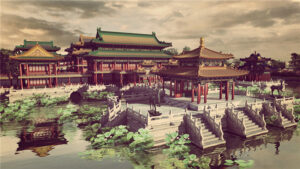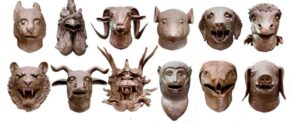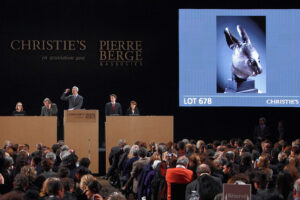
Virtual restoration of the Old Summer Palace during the Qing Dynasty, 1644-1911. (Copyright: Asianewsphoto)
Over two thousand years ago, the Jade Emperor, Supreme God of the Heavens in Taoism mythology, launched what is now known as the Great Race. The invitation was extended to every animal species in the Empire but, because of prior engagements or travel restrictions, only twelve (the Pig, Rooster, Sheep, Horse, Dog, Monkey, Snake, Rabbit, Dragon, Tiger, Rat, and Ox) attended the event. In gratitude, the Jade Emperor promised each participant it would be attributed a zodiac year and two hours of the day. The first to reach the finish line would become the first zodiac sign and the first two hours of the day, and so on. The race crossed all terrains, with its climax being a river crossing. Rat, the group’s smallest member, feared for its life; until it spied Ox. The bovine was known to have poor vision so Rat offered to direct it through the river by riding on its back. Ox agreed and they began the final leg of the journey. Yet once the pair grew close to the opposite bank, Rat jumped off Ox’s head and won the race. To this day, Rat remains the first sign in the Chinese zodiac and it symbolizes hours 11:00pm to 1:00am.
Under the Qing dynasty in the 18th century, Emperor Qianlong commissioned the creation of the Old Summer Palace in Beijing. Reigning over 715 acres of utopian hills and gardens, the palace hosted the empire’s formal and recreational stays. Within this land, hidden in the Garden of Eternal Spring, was the Haiyantang water-clock fountain. Giuseppe Castiglione, an Italian painter, designed the fountain to include twelve bronze heads in the shapes of the zodiac animals, which sprouted water at the hours to which the creatures were assigned in the Great Race myth. Water speared out of Rat’s mouth at midnight and Rabbit rose with the sun from 5:00 to 7:00am.
 In 1856, the British declared the Second Opium War against the Qing government. The French joined soon after. Four years into the war, British High Commissioner to China, James Bruce, the Eight Earl of Elgin entered the picture. The son of the Thomas Bruce (known for removing from marble frieze from the Parthenon), James Bruce ordered the burning and looting of the Old Summer Palace. Like his father, James has faced the ire of history due to his destruction and theft of a nation’s heritage. He knew that amongst the Chinese Palace’s treasures, the fountain’s bronze heads were no small catch. The French and British soldiers likely traded some of the loot amongst themselves. We now know most of the bronze heads were sent to Europe.
In 1856, the British declared the Second Opium War against the Qing government. The French joined soon after. Four years into the war, British High Commissioner to China, James Bruce, the Eight Earl of Elgin entered the picture. The son of the Thomas Bruce (known for removing from marble frieze from the Parthenon), James Bruce ordered the burning and looting of the Old Summer Palace. Like his father, James has faced the ire of history due to his destruction and theft of a nation’s heritage. He knew that amongst the Chinese Palace’s treasures, the fountain’s bronze heads were no small catch. The French and British soldiers likely traded some of the loot amongst themselves. We now know most of the bronze heads were sent to Europe.
World-renowned French fashion designer Yves Saint Laurent and his partner Pierre Bergé spent years acquiring an enviable art collection. From their first acquisition of a wooden bird sculpture, Oiseau Sénoufo, originating from Côte d’Ivoire in 1960, animals became a central theme in their collection. When Saint Laurent died in 2008, Bergé auctioned off a large part of their collection with Christie’s Paris the following year. Up for auction were the rat and rabbit heads. They may have gone unnoticed, but the Republic of China had had its eyes out for the bronzes for nearly a decade. Back in 2000 the tiger, the monkey, and the ox were the first zodiac heads to reappear on the public art market. At the time, they were featured in Christie’s and Sotheby’s auction catalogues for their upcoming sales. The Chinese State Bureau of Cultural Relics promptly wrote to the auction houses demanding the withdrawal of the bronze heads from the sales. The Chinese government did not formulate an official restitution request because international conventions were viewed as inapplicable to lootings that occurred over 140 years ago. As a result, the auction houses rejected the State’s request. In an unexpected turn of events, however, China Poly Group Corp. Ltd.placed its live bids on all three heads, and won them for a total of $4 million dollars. The sculptures were placed in this state-owned corporation’s Poly Art Museum in Beijing, which is dedicated to Chinese heritage. Three years later, the same museum acquired the pig head from Chinese billionaire Stanley Ho, who had bought it from a New York collector. Finally, in 2007, Ho purchased the horse head from Sotheby’s Hong Kong for $8.9 million dollars.

Jackie Chan wrote, directed, and starred in a film about the stolen zodiac bronzes.
It came as no surprise when Christie’s Paris received a letter from the Chinese government in February 2009 asking that the rat and rabbit heads be removed from the Yves Saint Laurent-Bergé sale. It was also to be expected that the auction house would refuse. In protest, the “Association pour la protection de l’art chinois en Europe” (the Foundation for the protection of Chinese art in Europe) along with eighty other Chinese lawyers, filed a complaint with the “juge des référés” whose role in France is to deliver temporary restraining orders in time-sensitive situations. Two days before auction, the tribunal rejected the foundation’s request to enjoin the sale.
THE PROVENANCE: In its press release on the three-day Saint Laurent estate sale, Christie’s described the zodiac bronze heads as the “two main pieces” amongst the works for sale. The sculptures’ provenance revealed that Saint Laurent had acquired them from the Kugel brothers at their famous Galerie Kugel in Paris. The Kugels bought the bronze heads from the marquis de Pomereu in 1986 who had attained them from the Spanish painter José María Sert.
On the closing day of the sale, February 25, 2009, the rat and rabbit bronzes sold for the equivalent of nearly $40 million. A few days later, the winning bidder refused to pay for them. Cai Mingchao, a self-described Chinese patriot, explained his act was a national duty. “This money,” he claimed, “should not be paid.” The Chinese government publicly supported Mingchao’s fraud and, in addition, placed tighter trade restrictions on Christie’s art trades, ordering local law enforcement officials to report any artifact that might have been looted and trafficked. Following Mingchao’s refusal to pay for the sculptures, Pierre Bergé eventually sold the lots to French billionaire François Pinault, the owner of Christie’s.

Rabbit bronze for auction at Christie’s (Copyright: Agence France-Presse)
However, the story was not over. In 2013, Pinault announced that the rat and rabbit heads would return to Beijing. But the animals’ race home came at a price. Curiously, this donation occurred only a few days after Christie’s was granted a license to conduct business on mainland China. Most recently, in December 2020, China’s National Cultural Heritage Administration launched the return of the horse head. The Summer Palace was restored in 1886, twenty-six years after its destruction. However, the dragon, dog, sheep, snake, and rooster have yet to reach to finish line and return home.